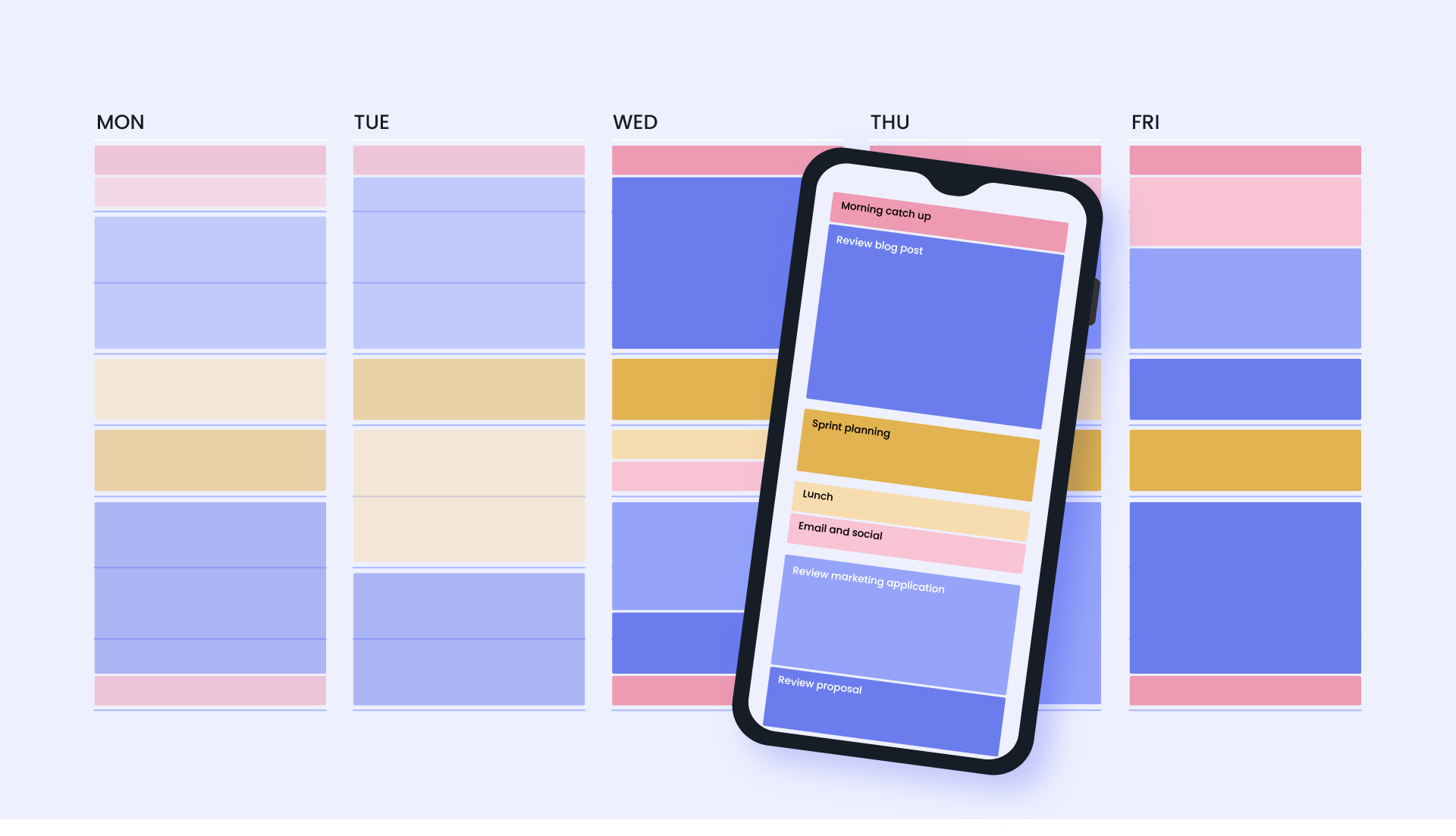Did you know the average manager spends up to 23 hours/week in meetings? At first glance, that's over half the standard 40-hour workweek — but with such a heavy meeting cadence, managers are stuck working extra hours into nights and weekends just to catch up. But what exactly is a meeting cadence? Simply put, it’s the rhythm and frequency a team holds regular meetings.
Getting your meeting cadence right can make or break a team’s productivity. In fact, up to 46% of employees feel they attend too many meetings. But aren't managers supposed to be in meetings? Of course! But this doesn't mean they don't need heads-down time to support their team. Without this uninterrupted time, managers will fall behind on tasks like reviewing work, managing projects, planning, and recruitment. So, finding the right balance is critical in keeping the team on target while avoiding overwhelming them with too many meetings. With so much at stake, managers must understand the key factors contributing to an effective meeting cadence.
In this article, we’ll explore why meeting cadence is so critical for busy managers, common pitfalls to avoid, and tips for finding the right cadence for your team.
What is a meeting cadence?
Meeting cadence refers to the regular schedule of meetings within a team. It encompasses their frequency, duration, and priorities – with a usual rhythm of daily, weekly, monthly, or quarterly occurrences.
Establishing a consistent meeting cadence is essential for several reasons. First, it keeps the team on the same page so progress is made toward shared goals. Second, it helps reduce the number of ad hoc meetings and interruptions, allowing team members to focus on their work without unnecessary distractions.
Why teams suffer from bad meetings
Many of us are familiar with the pain of unproductive meetings. Despite being a crucial part of collaboration and decision-making, meetings can often be a source of frustration and wasted time. This meetings trend report which surveyed over 15,000 people found that ‘busy’ professionals (who average more than 15 meetings/week) spend 32.9 hours/week in meetings. And the average professional isn't immune from such a heavy meeting schedule either, clocking in at 21.5 hours/week.
The burnout trends report also found that all this time in meetings significantly contributes to burnout – with 48.2% of professionals reporting too many on their plate. As a result, people struggle to set aside enough focus time (dedicated and uninterrupted time blocks for productive work). So, they’ll find themselves behind on their goals, often leaving them under-prepared for their next meeting. A painful cycle of unproductivity that’s hard to break.
And with all of these meetings on the calendar, many teams struggle to even get value out of the meetings they’re obligated to attend. Here are some of the top reasons meetings are unproductive:
1. Lack of agenda
When meetings lack a clear agenda or structure, it can lead to lots of wasted time. Attendees will struggle to understand what topics will be covered and what is expected. This can also open up the room for off-topic discussions, which can further derail the whole meeting and cause it to lose focus. Likewise, when attendees come unprepared, it’s challenging to progress on any given topic. These factors can cause the meeting to drag on longer than necessary.
2. Too many attendees
When you invite too many people to a meeting, it’s challenging to keep everyone engaged and focused. And in most cases, everyone doesn’t need to be there. For larger cross-department meetings, it’s best to send one rep from each group instead of everyone on that team. That way, a single person can speak to a project from that team’s perspective without wasting the time of unnecessary attendees.
Too many attendees also complicate the decision-making process. Keep Jeff Bezos’s “Two Pizza Rule” in mind — two pizzas should be enough to feed the group.
3. Lack of action items
Meetings need to have explicit objectives which lead to outcomes and action items. Otherwise, they are a waste of time. Without actionable takeaways, participants leave feeling frustrated, unmotivated, or downright confused as to why the meeting was even necessary vs. sharing a simple status report.
4. Poor time management
Meetings that run long or start late can irritate participants who may be busy enough as it is. The average professional has to handle 5.1 meetings/day. This means they face about 25.6 possibilities of a meeting conflict every week. If a manager doesn’t manage a meeting’s time properly, these conflicts become even more likely.
So, it is crucial to be considerate of everyone’s time. If your meetings typically drag, you may need to meet more (assuming they are well-organized with a clear agenda and minimal off-topic discussions). A meeting leader is also necessary to keep everyone on track so you don’t keep people longer than you need.
Okay, that’s all well and good, but what does this have to do with the cadence of meetings? Well, no matter the meeting rhythm that you choose, it’ll all be for naught if the meetings aren’t bearing fruit. Managers can better identify the best cadence by understanding whether or not their meetings are productive. In doing so, they can book the right number on their calendar.
How often should we meet?
Okay, now for the meat and potatoes: how often should you hold meetings?
Determining how often your team should meet primarily depends on several factors, including the urgency of the work being done, how dependent team members are on one another, where team meetings are to be held, and their size.
Daily meetings
Daily meetings are typical for teams working on time-sensitive projects. They’re usually brief and focused (15-30 minutes), and help team members stay aligned on goals and priorities. For example, software and product teams may attend daily standups to collaborate on an upcoming product launch. Marketing teams may check in on active campaigns. Legal and finance teams could meet as a company navigates a merger or an acquisition. Really, any team could have time-sensitive projects on their plate and use daily meetings to check in on progress, blockers, and next steps.
Common types of daily meetings include:
- Standup meetings: Standups are usually held at the beginning of the workday and are intended to be quick check-ins. Each team member shares what they worked on the previous day, what they plan to work on that day, and any obstacles they’re experiencing.
- Huddles: Similar to standup meetings, huddles are quick check-ins held throughout the day to keep everyone on the same page. As the name suggests, they are rapid-format meetings.
Weekly meetings
A weekly meeting cadence is another favorite for many teams – they are recurring opportunities for everyone to connect, share progress updates, and discuss vital challenges, roadblocks, and priorities. It’s also a great time to make any necessary adjustments to keep everyone on track, allowing the team to work together effectively towards its goals.
Common types of weekly meetings include:
- Team meetings: A weekly team meeting is usually led by the team leader and allows the group to discuss progress, roadblocks, and priorities for the upcoming week.
- One-on-one meetings: One-on-ones are often held between a manager and an individual team member, which allows for more personalized discussions about progress, goals, and any concerns.
Monthly meetings
Monthly meetings may be more appropriate for groups with less urgent projects that still need regular check-ins to ensure progress is being made. Monthly meetings provide enough time for projects to advance while allowing enough room for accountability. However, if monthly meetings seem too infrequent, bi-weekly meetings may be a better option to keep everyone on track so tasks are completed promptly.
Common types of monthly meetings include:
- Management meetings: These meetings allow managers across departments to review progress made over the previous month, and discuss any updates or improvements to consider across teams within the organization.
- Strategic planning meetings: Strategy meetings focus on longer-term goals and strategies, and are typically used to look at big-picture perspectives and discuss new strategic challenges, risks, threats, and opportunities for the future.
Quarterly meetings
Companies often reserve a quarterly meeting cadence for much grander initiatives or executive-level updates. These meetings focus on longer-term planning and strategies rather than day-to-day operations. The goal is to keep the company moving in the right direction and continue achieving its goals. Quarterly meetings can be critical for decision-makers to make informed choices regarding the company’s future direction.
Common types of quarterly meetings include:
- Board of Directors meetings: These meetings are held by the board of directors to review the company’s performance and make decisions about future plans.
- Company-wide meetings: Company-wide meetings are usually led by executives and provide updates on company-wide initiatives and goals. As the name suggests, every member of an organization is involved.
Remember, there’s no one-size-fits-all answer to finding the right meeting cadence. As a manager, assess your team’s unique needs to create a cadence of both one-off and recurring meetings that work for your goals.
And guess what? You’re not in this alone. No one understands the needs, objectives, and working styles better than the team themselves. Always get input from your team members about how often you should meet.
If you want to optimize your team’s meeting cadence, take advantage of a productivity app like Reclaim.ai. The AI-powered scheduling app integrates with your team's calendar, making it a breeze to strike the right balance between meetings and focused work time – and analyze where you’re spending your time every week
Limiting your meetings with asynchronous communication
Before we see you off, we’ll leave you with a word on asynchronous communication. As the name suggests, this communication method does not require your team to be present for a meeting. It allows team leaders and members to communicate and collaborate on their own schedules, which can be especially helpful when working across different time zones or juggling multiple priorities.
Sometimes meetings simply aren’t necessary. As the saying goes: “this could have been an email.” Async communication, whether via email, instant messaging, or with tools such as Reclaim, Slack, or your teams' project management app, can be effective for many types of communication – especially status updates.
So what’s the best balance for synchronous and asynchronous meetings? You may need in-person meetings for critical discussions, like brainstorming and decision-making. But, by using asynchronous communication for less essential communication, teams can ensure their weekly and monthly meeting cadence is productive and efficient.
Get your meetings back on track 🙌
Establishing the proper meeting cadence can make all the difference for busy teams and managers to stay on top of their workload. By understanding the urgency of work, team member dependencies, and how much heads-down work your team needs time for every week, you can find a recurring meeting rhythm that supports your team’s productivity and collaboration.
How do you feel about your weekly meeting schedule? Anything we missed? Tweet us @reclaimai to get in on the conversation!
































